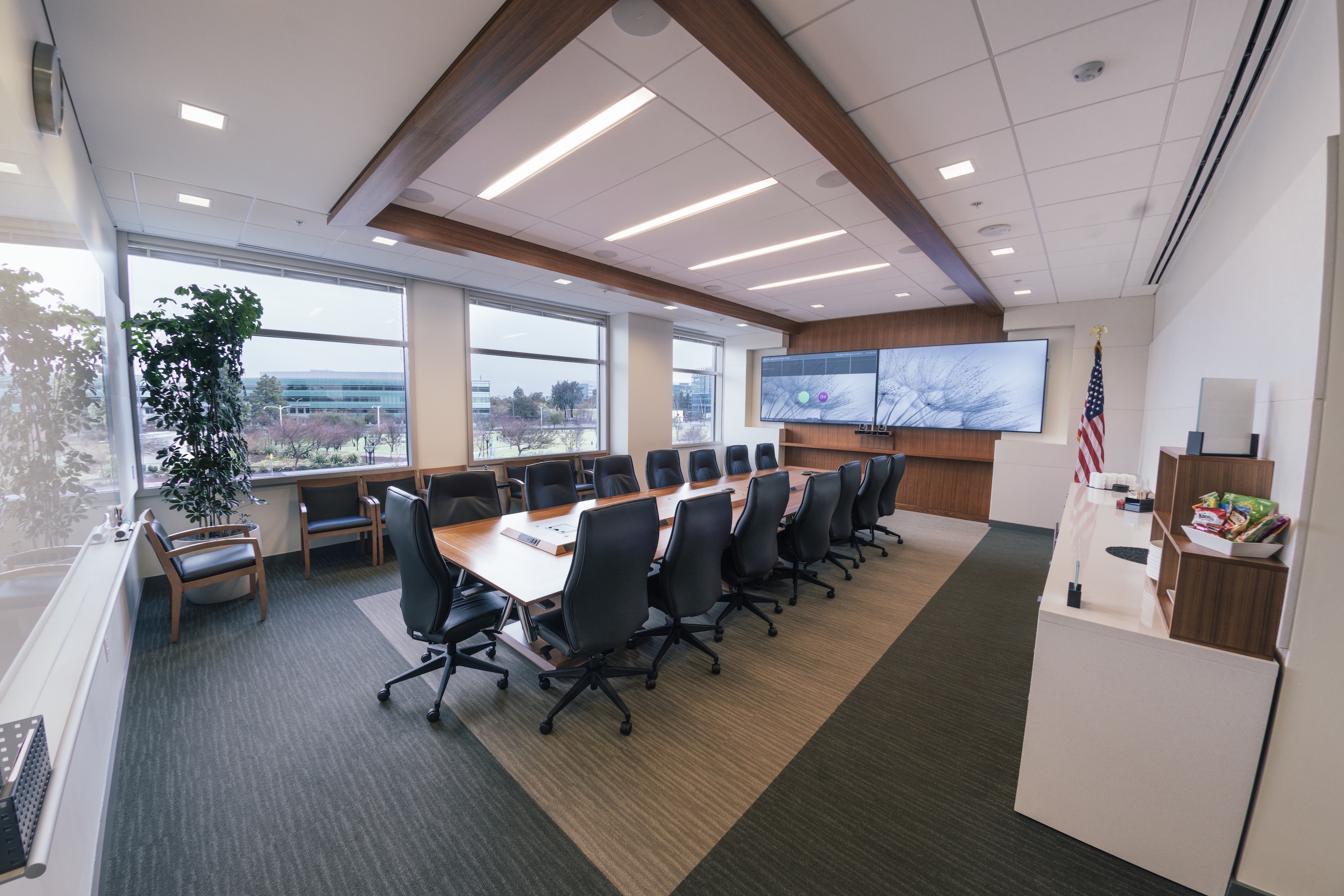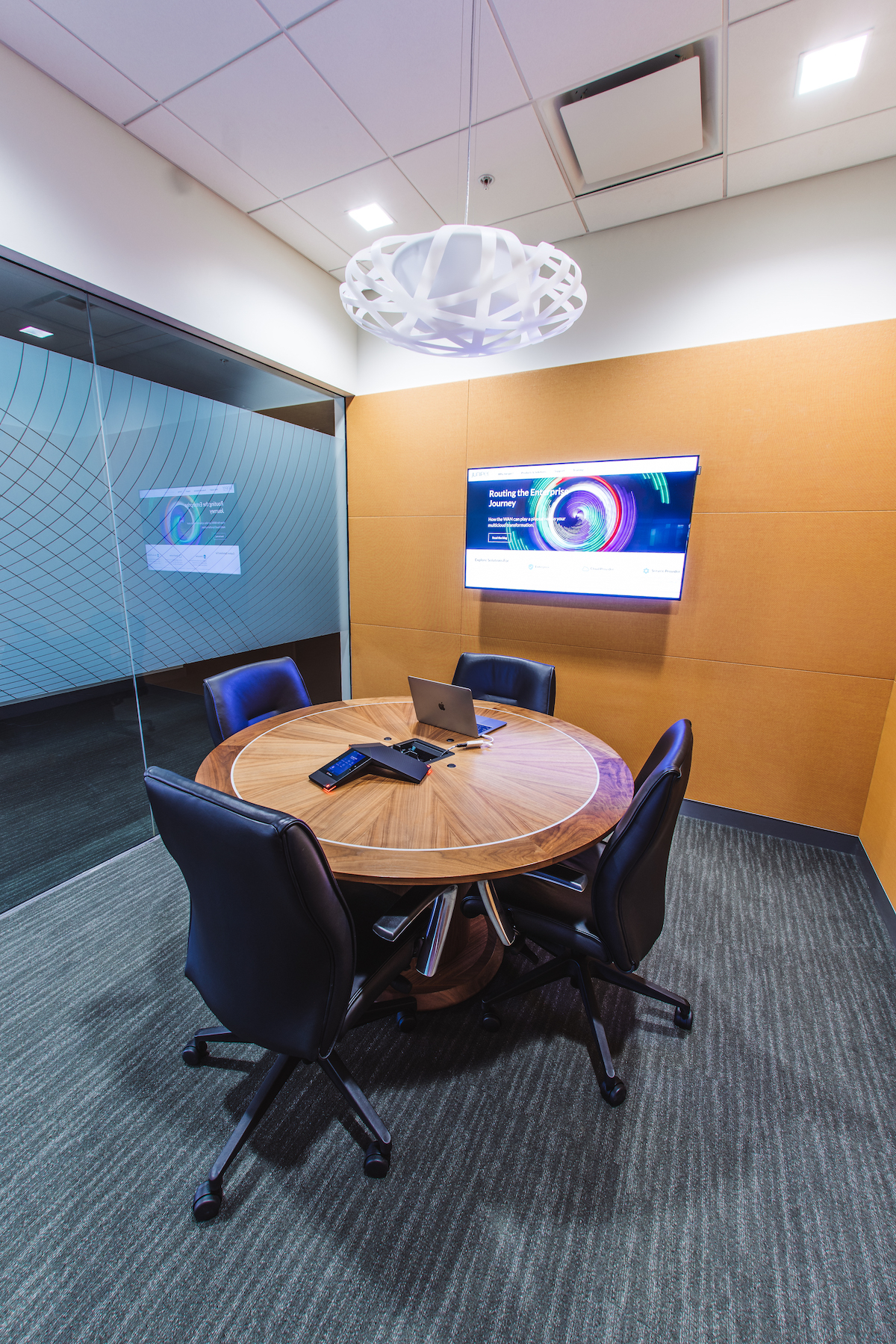The Conference Room of the Future, Standardized
AV over IP is the way of the future. It’s all you hear in the industry. So, to start a job at a company that was outfitting its enormous headquarters with fully end-to-end networked AV systems sounds like the ultimate thrill, right?
Perhaps it would be in 2019; but six years ago, for a pragmatic industry veteran like Pete Kolak, it was a prescription for managerial migraines.

“I was working at Adobe when this role popped up,” said Kolak, senior manager of conferencing services at Juniper Networks, an international networking company based in Sunnyvale, CA. “Everyone in the Bay Area knew that Juniper was doing this giant upgrade with all this networked AV, where everything you plugged into and every destination was encoded and decoded on the network. I almost didn’t apply because that sounded like a total nightmare to support.”
But he decided to tackle the task anyway. “I get onsite and I’m looking around and looking at everything, and basically every signal—input and output—is encoded, sent on the network, and sent back, and that can cause some latency,” he said. “There were a lot of challenges, and the tremendous amount of traffic on the network from the AV equipment actually helped Juniper improve their switches.”
Over his first three months on the job, he and his team worked tirelessly to stabilize the AV programming and settings on the AV gear, to get to a point where it was manageable enough to start on an overhaul plan.
A SOLID FOUNDATION
When he joined Juniper in June of 2013, Kolak had amassed more than 15 years of experience in managing communications technology, so he had a solid foundation of how to engineer reliable systems—and how to fix them when things went awry. He started at a company called Turn-Key Operations, managing its telecommunications, specifically its Madge Teleos switch-based system. From there, he joined Blue Shield of California as its conferencing services lead, where he handled the design of audio conferencing, videoconferencing, video production, and data collaboration for the entire enterprise.
A daily selection of features, industry news, and analysis for tech managers. Sign up below.
It wasn’t until joining Adobe as its conferencing services engineer in 2010, however, that he became fully immersed in the world of IT. “Network was a huge jump,” he said. “More than half of my career I was working in non-IP-based environments. IP was a challenge because I knew telecom, and trying to troubleshoot a network with a network team, trying to use the same verbiage I used to use with the telecom people—it was different. It was a struggle and it took a while.”
Kolak eventually gained a mastery of it from hands-on learning. “I had to work really closely with the network team to understand how it worked,” he said. “It was just trial and error, and troubleshooting, and learning what they did to fix things over time, and learning what to ask for when you saw the same problems arise.”
A GOLD STANDARD
At both Adobe and Blue Shield, part of Kolak’s responsibilities included developing standards for the companies’ AV systems. Once he was able to get enough of a handle on the network at Juniper, he sat down with his engineering team and formulated a plan to simplify and standardize its communications system on a set of three basic room configurations: presentation only, audio conference rooms, and videoconference room options. Along with this, he established a hybrid AV distribution system, where audio and video were routed locally unless it made more sense to send them over the network. “We kind of turned it back to almost a standard-type room connection, where the video in the room is just in the room and not going on the network, because of latency issues inherent in IP transport,” he said.

He has since been working to incorporate this standard in Juniper’s roughly 500 rooms across some 40 global offices. About 25 percent of them are equipped for videoconferencing, and the rest are a combination of presentation and audio. All of the larger, video-conferencing-enabled rooms feature Crestron control and touchpanels, Samsung monitors—most in a dual-display configuration—Polycom videoconferencing equipment, Shure microphones, QSC amplifiers, and Crestron DM matrix switchers in rooms that need them.
The other room types follow the same basic configuration, just scaled back. “We started out by designing the biggest room, then stripping pieces out to make it a smaller room, so it’s basically the same flow and function,” he said. There are also some non-standard rooms, like event spaces and huddle areas, which are only equipped with a Polycom Trio phone for one-touch Skype dialing and a wall-mounted display.
Particularly important for Kolak was that these spaces remain flexible in terms of software ecosystems. “We use Polycom videoconferencing because we wanted to stay agnostic from any one technology that’s out there,” he said. “I don’t want to be a Zoom room or a Google Hangout room, because you never know—one day people could decide that they hate Skype and they want to go to [Microsoft] Teams, or they want to go to Zoom. I don’t want to be nailed down to just one technology, otherwise if anything changes, it could be an expensive change instead of just a backbone change.”
DISAPPEARING ACT
Kolak said that one of his initial goals when restructuring Juniper’s conferencing spaces was to make them automatic. “When I talk with people, nobody ever wants to control the cameras, pressing buttons, joining conference calls, things like that,” he said. “So, we invented an autonomous conference room: you walk in, the room turns on, you plug in your monitor, and it shows your content. If a call is scheduled, it automatically joins it; when you leave the room, everything turns off automatically.”
All of the three standard rooms operate this way, with occupancy sensors triggering the LCD screens to turn on when participants enter. “You know how it takes about five to 10 minutes to start a meeting a lot of the time?” Kolak said. “At our company, it’s about 10 seconds. The rooms auto-route the video content when you plug in, and in some cases, it will auto connect you into the meeting you have scheduled if you desire, or you can do a one-touch join into your meeting as well. When you leave the room, the system shuts off.”
Beyond saving time, he believes that minimizing interaction with technology is key for maximizing utilization. “Making the technology disappear is actually more comfortable for the customers,” he said. “We might think it’s really cool; I would love to show everybody under the hood how everything works. But most people, when you walk in our rooms, you just see furniture, microphones, and monitors on the wall—that’s the extent of how we showboat our technology.”
TEAMWORK

Departmental collaboration is important for Kolak’s work at Juniper. His team is part of the IT department, so he says he gets along really well with its other staff members. One division is the network team, to which conferencing services’ work is closely tied. “We are a network company, and we have to work closely with them to make sure things are profiled, and if a device falls offline, to find out why,” he said. There is a unified communications team, and Kolak works with them to oversee the operation of the company’s Polycom equipment, troubleshooting issues with call drops, static, and things on the line. “We also work very closely with the accounts teams, with the email teams, to get everyone to create accounts,” he said.
In addition, Kolak said he maintains a working relationship with the company’s vendor programmers to ensure their code is universal for all conferencing room types. “I want to make sure that our code isn’t overly complicated, but is able to have things switched on here and there to make it work with any room type,” he said. “Every couple of weeks, I’ll get together with our programmer remotely and just make sure we’re doing the right thing and keeping our code up to date.”
DAILY DETAIL
Even with a conferencing system as carefully engineered as Juniper’s, things invariably go wrong—and getting them back in working order occupies a lot of Kolak’s time on a daily basis. “You’re chasing network things, things falling offline,” he said. “We do a lot of ‘Why did this device fall offline?’ troubleshooting and trying to get to root causes. A lot of times it’s the device; a device will fail, or a device will just fall asleep.”
Staying on top of security is key for every internet-connected enterprise, and Juniper is no exception. Because most of the AV devices now use dedicated switchers, the risk of intrusion is minimized. Wherever possible, encryption is used. “Our Shure microphone signals are all encrypted, we also obviously have password protection on all of our devices around the company,” Kolak said. Juniper uses AVI-SPL’s Symphony to keep tabs on how everything is operating, and to ensure no unauthorized activity is taking place. “We monitor our equipment’s health to see if something’s offline, and everything has to be remotely accessible, so we can log on to see if somebody’s changed a password or sending it something.”

In addition to overseeing all of the devices and infrastructure, Kolak also does a lot of customer support work, providing employees with instruction on setting up calls, scheduling meetings, and making sure they know how to use rooms properly.
REFRESHING
With roughly 40 global offices in every region, from EMEA, to APAC, to the U.S., Juniper has a lot of rooms to outfit with technology—so making sure it’s all up to date can be challenging. According to Kolak, there wasn’t a strategy for refreshing it when he came onboard. So, he came up with one himself, based around a five-year schedule. “I went to the director who was here before me who was in charge of the engineering team, and said ‘Hey, I just did inventory of all of our equipment around the world. And if you were to replace it with the current standard at the time, you would need X million dollars. You divide that by five, and you just do that much every year, and every five years you cycle back.’”
He received approval for this plan three years ago, so the first cycle is not yet complete. “We still have some APAC sites to refresh, and a couple sites here in the U.S. We’re almost done, then we’ll be starting over.”
DOING IT RIGHT
Kolak’s number-one piece of advice for technology managers? Stay consistent. “That’s something I’m kind of crazy about,” he said. “I want to make sure that whatever we’re doing, we keep everything as consistent as possible.”
But keeping things simple isn’t so easy. Kolak said that one particular challenge he faces is pressure to pursue the latest technology, which isn’t always better. “That’s the hardest thing in my career and in my whole life: You would think that everyone would be onboard with being consistent, but even my engineers on my own team will see something bright and shiny and get interested in it,” he said. “And I’ll have to ask, ‘How does that tie into what we’re doing? What does that fix or replace?’ So just running to do the next greatest thing, it’s really hard to maintain standards.”
To help prevent such misguided diversions from the established order, Kolak urges technology managers to work closely with upper management and make sure you’ve communicated your vision and plans with them.
Finally, when developing standards, Kolak believes there should be clear objectives in mind. “What are you designing your standards for, and why are you even making them?” he said. “For example, we came up with a list of things we’re trying to accomplish with our standards—things like making sure that the meeting can start as quickly as possible.”
So what’s next? Kolak is open to moving more AV resources back to the network in the future—as long as it makes things simpler, and doesn’t deviate from his core objectives.
Matt Pruznick is the former editor of AV Technology, and senior editor for Systems Contractor News and Residential Systems. He is based in New York.

